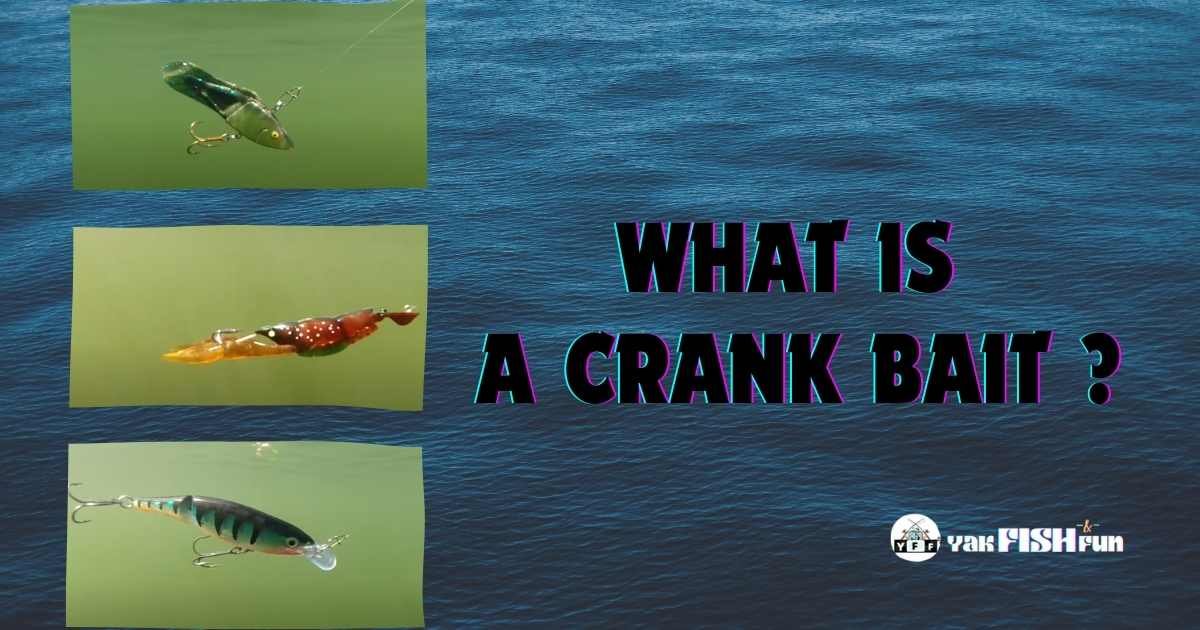A crank bait is a type of fishing lure designed to mimic the movement of prey fish. It is commonly used to attract predatory fish. These lures have a distinct wobbling action that imitates the swimming motion of smaller fish. They are highly effective in both freshwater and saltwater environments.
Anglers use crank baits to target species like bass, pike, and walleye. The lure’s built-in lip or bill helps it dive to different depths, enhancing its appeal. Crank baits are easy to use and can cover large areas of water quickly, increasing the chances of a successful catch. Their effectiveness and simplicity make them a staple in any angler’s tackle box.
Crank baits come in various shapes, sizes, and colors, making them versatile tools for anglers.
In this post, we will delve into the world of crankbaits, exploring their design, different types, and how they can be used to improve your fishing success.
Table of Contents

What Are Crankbaits And What Do They Look Like
Crankbaits are fishing lures designed to imitate the movement of small fish. They often feature a lip that helps them dive and wobble underwater. Available in various shapes and colors, they effectively attract predator fish.
Crankbaits are essential for any angler’s tackle box. These versatile lures mimic small fish, enticing predators to bite. Understanding crankbaits and their appearance can elevate your fishing game.
What Are Crank Baits?
Crankbaits are artificial lures designed to imitate the movement of baitfish. They are highly effective for catching predatory fish such as bass, pike, and walleye.
- Design: Crankbaits typically have a hard plastic or wooden body.
- Action: They feature a wobbling or darting action, mimicking injured prey.
- Buoyancy: Available in floating, sinking, or suspending types.
- Sound: Many crankbaits include rattles to attract fish.
What Do Crank Baits Look Like?
Crankbaits come in various shapes, sizes, and colors. Each design serves a specific purpose, targeting different fish species and water conditions.
- Body Shape: Round or slender, resembling different baitfish.
- Lips: Short lips for shallow diving, long lips for deep diving.
- Colors: Bright colors for murky water, natural colors for clear water.
- Patterns: Scales, stripes, or holographic finishes.
Exploring different crank bait designs can help you find the perfect lure for any fishing scenario.
How Does A Crankbait Work And How To Rig A Crankbait
A crankbait mimics the movement of a distressed fish, attracting predators with its wobbling action. Rigging involves attaching it to a fishing line, ensuring secure knots for optimal performance.
Crankbaits are a must-have for any angler looking to catch bass or other predatory fish. Their lifelike appearance and movement make them irresistible to fish. Understanding how a crankbait works and how to rig it properly can significantly improve your fishing success.
How Does A Crankbait Work
Crankbaits are designed to mimic the swimming action of baitfish. This action triggers predatory instincts in fish, making them strike.
- Lipped Design: The lip or bill on the front causes the bait to dive and wobble.
- Buoyancy: Crankbaits float at rest but dive when retrieved.
- Rattle Chambers: Some models include rattles to attract fish with noise.
- Color Patterns: Various colors and patterns imitate different types of prey.
How To Rig A Crankbait
Rigging a crankbait correctly is vital for its performance. Follow these steps to ensure your crankbait is ready to catch fish.
- Attach to the Line: Use a snap or a loop knot for a natural wobble.
- Choose the Right Line: Opt for fluorocarbon or monofilament; they offer the right stretch and strength.
- Adjust the Hooks: Ensure the hooks are sharp and properly aligned.
- Test in Water: Cast into shallow water to check the action before fishing.
By mastering these techniques, you’ll enhance your crankbait’s effectiveness and increase your chances of a successful catch.
Types Of Crankbaits – Lipless, Shallow, Deep
Crankbaits are essential fishing lures that mimic baitfish. Different types include lipless, shallow, and deep divers, each designed for specific depths and conditions. Lipless crankbaits excel in open water, shallow ones navigate near the surface, and deep divers target fish in deeper waters.
Crankbaits are a staple in every angler’s tackle box, designed to mimic the movement of prey fish. These lures are versatile and come in various types to suit different fishing conditions. Understanding the different types of crankbaits can significantly improve your fishing success.
Lipless Crankbaits
Lipless crankbaits are unique due to their lack of a protruding lip, which affects their movement in water. Let’s dive into their characteristics:
- Vibration and Noise: Lipless crankbaits create a lot of vibration and noise, attracting fish from a distance.
- Versatility: They can be used in various depths, making them suitable for both shallow and deep waters.
- Sinking: These crankbaits sink rather than float, allowing for different retrieval speeds and depths.
- Effective in Weedy Areas: Their design allows them to move through weeds without getting tangled.
Shallow Diving Crankbaits
Shallow diving crankbaits are perfect for fishing in waters less than 5 feet deep. Here’s what makes them special:
Shallow diving crankbaits are ideal for targeting fish that stay close to the surface.
- Short Lip: These crankbaits have a short lip that helps them dive to shallow depths.
- Great for Cover: They excel around structures like fallen trees and rocks.
- Wide Wobble: Their wide wobble action is perfect for enticing fish in clear, shallow waters.
Deep Diving Crankbaits
Deep diving crankbaits are designed to reach fish that dwell in deeper waters. They are essential for certain fishing conditions:
- Long Lip: The long lip allows these crankbaits to dive deep, sometimes reaching depths of 20 feet or more.
- Targeting Deep Fish: Perfect for catching fish species that live in deeper water columns.
- Steady Retrieve: A steady retrieve helps maintain their depth and attract fish lurking in the deep.
With these types of crankbaits in your arsenal, you can effectively cover various water depths and conditions, ensuring a successful fishing trip.
When Should You Use Crank Baits
A crankbait is a fishing lure designed to mimic the movement of fish. Use crankbaits in murky waters or during aggressive feeding times for the best results.
Crank baits are a versatile tool in any angler’s tackle box. Ideal for attracting a variety of fish, these lures mimic the movement of prey. But when should you use them to maximize your catch?
During Specific Seasons
Knowing the right time of year to use crank baits can make a significant difference:
- Spring: Fish are more active and aggressive, making crank baits effective.
- Fall: Cooler water temperatures mean fish are feeding more, perfect for crank bait use.
In Different Types Of Water
The type of water you are fishing in will influence your choice:
- Clear Water: Use natural-colored crank baits to mimic local prey.
- Murky Water: Brightly colored crank baits are more visible to fish.
Targeting Specific Fish Species
Certain fish are more likely to respond to crank baits. Here are a few examples:
- Bass: They are highly responsive to the erratic movement of crank baits.
- Walleye: Often found in deeper waters, these fish are attracted to deep-diving crank baits.
Fishing In Various Depths
The depth at which you are fishing can dictate the type of crank bait to use:
- Shallow Water (1-4 feet): Use shallow-diving crank baits.
- Deep Water (10+ feet): Opt for deep-diving crank baits to reach the fish.
During Different Times Of Day
The time of day can affect fish behavior and crank bait effectiveness:
- Morning: Fish are often more active, making crank baits a good choice.
- Evening: Cooler temperatures can make fish more aggressive, ideal for crank bait use.
Crank baits are highly effective if used in the right conditions. Understanding when to use them will increase your chances of a successful fishing trip.
Different Techniques When Fishing With A Crankbait
A crankbait mimics the movement of baitfish, attracting predator fish with its wobbling action. Varying retrieval speeds, pausing, and using deflection techniques can effectively trigger strikes.
Fishing with a crankbait can be a thrilling experience. This versatile lure mimics the movement of small fish, making it irresistible to predators. Understanding different techniques can elevate your fishing game and increase your chances of a successful catch.
Casting And Retrieving
Casting and retrieving is a fundamental technique:
- Cast out: Throw the crankbait into the water, aiming for spots where fish are likely to be.
- Steady retrieve: Reel in at a constant speed to simulate a swimming baitfish.
- Vary retrieve speed: Change the pace to trigger a predatory response from fish.
Stop And Go
The stop-and-go method involves pauses:
This technique can make the crankbait appear more lifelike, enticing fish to strike.
- Cast and reel: Start with a regular retrieve.
- Pause intermittently: Stop reeling for a few seconds.
- Resume reeling: Continue at varying speeds after the pause.
Bumping And Grinding
Bumping and grinding can provoke aggressive strikes:
- Target structures: Aim for rocks, logs, or underwater vegetation.
- Drag the lure: Let the crankbait bump against these structures.
- Reel through: Continue retrieving after each bump to simulate an injured fish.
Deflection
Deflection is about creating erratic movements:
This technique can confuse fish, making them more likely to bite.
- Hit obstacles: Allow the crankbait to hit underwater structures.
- Change direction: Let the lure deflect off the obstacle.
- Vary speed: Adjust your retrieve speed after deflection.
Long Lining
Long lining covers more water:
- Cast far: Make long-distance casts to reach deeper or farther areas.
- Slow retrieve: Reel in slowly to keep the crankbait at the desired depth.
- Maintain tension: Ensure the line stays taut to detect strikes.
Mastering these techniques can make your crankbait fishing more effective. Each method offers unique advantages, helping you attract and catch more fish.
Difference Between A Jerkbait And A Crankbait
Crankbaits are fishing lures with a wide, wobbling action designed to dive to specific depths. Unlike jerk baits, crankbaits mimic fleeing prey, enticing fish to strike.
Fishing enthusiasts often debate the merits of different types of lures. Among the most popular are crankbaits and jerkbaits. Understanding the difference between these two can enhance your fishing strategy.
Action And Movement
Crankbaits and jerk baits differ significantly in their action and movement.
- Crankbaits: Designed for consistent movement; they dive and wobble through the water.
- Jerkbaits: Require manual jerks; they mimic the erratic movement of injured prey.
Depth Range
Each type of bait operates at different depths, affecting their effectiveness.
Crankbaits typically dive deeper. They are ideal for reaching fish that dwell at various depths. Jerkbaits, on the other hand, usually work best in shallow waters, staying closer to the surface.
Shape And Design
The shape and design of these lures also set them apart.
- Crankbaits: Bulky and round; they create more water resistance.
- Jerkbaits: Slim and elongated; they cut through water easily.
Usage Technique
Knowing how to use each lure can make a big difference in your fishing success.
Crankbaits are simple to use. Just cast and reel them in. Jerkbaits require more skill, involving a series of jerks and pauses to mimic live bait.
Target Species
Different fish species respond better to different types of lures.
- Crankbaits: Effective for bass and walleye; they attract fish with their steady motion.
- Jerkbaits: Great for targeting predatory fish like pike and musky; their erratic action triggers strikes.
Seasonal Effectiveness
The time of year can influence which lure works best.
Crankbaits excel in warmer months. They cover more water and attract active fish. Jerkbaits shine in colder months, when fish are sluggish and require more enticing movements.
Tips And Tricks On Using Your Crankbaits Successfully
Crankbaits mimic the movement of baitfish, attracting predatory fish. Effective use requires varying retrieval speeds and patterns. Experiment with different depths and colors to find what works best in your fishing spot.
Crankbaits are a favorite among anglers for their versatility and effectiveness. To help you make the most of your new crankbaits, we’ve compiled some useful tips and tricks. From selecting the right gear to mastering retrieval techniques, we’ve got you covered.
Choosing The Right Gear
Selecting the appropriate gear can significantly impact your crankbait fishing success. Here are the essentials:
- Rod: Choose a medium to medium-heavy rod for better control.
- Reel: Opt for a baitcasting reel with a smooth drag system.
- Line: Use fluorocarbon or monofilament line for optimal sensitivity and stretch.
Mastering Retrieval Techniques
Different retrieval techniques can attract various types of fish. Experiment with these to find what works best:
- Steady Retrieve: Keep a consistent speed to mimic a swimming baitfish.
- Stop-and-Go: Pause occasionally to imitate a wounded prey.
- Deflect Off Structures: Bounce the crankbait off rocks or logs to trigger strikes.
Timing And Conditions
Understanding the best times and conditions for using crankbaits can enhance your fishing experience. Consider these factors:
Crankbaits perform well in different seasons and water conditions. Warmer months and clear waters often yield the best results. Fish tend to be more active during dawn and dusk, so target these times for increased chances of success.
Color And Size Selection
Choosing the right color and size is crucial for attracting fish. Here are some guidelines:
- Match the Hatch: Select colors that resemble local baitfish.
- Water Clarity: Use bright colors in murky water and natural colors in clear water.
- Size Matters: Smaller crankbaits work best for smaller fish, while larger ones attract bigger catches.
Fine-tuning Your Crankbait
Fine-tuning your crankbait can make a big difference in its performance. Make small adjustments for better results:
Tweak the lure’s components to suit your fishing needs. Bend the eyelet slightly to adjust the lure’s swimming pattern. Change the hooks if necessary for better hooksets.
Covering Water Efficiently
Covering more water increases your chances of locating fish. Implement these tips and tricks to maximize your crankbait fishing success.
Here’s how to do it effectively:
- Fan Casting: Cast in a fan pattern to cover a wide area.
- Depth Variation: Vary your casting distance to explore different depths.
- Move Frequently: Don’t linger in one spot for too long if there’s no action.
When Should I Use A Crankbait?
Use a crankbait in clear water during spring and fall. It’s effective when fish are active and chasing prey.
What Is The Difference Between A Jerkbait And A Crankbait?
A jerk bait mimics injured fish with sharp, erratic movements. A crankbait dives and wobbles steadily to attract fish.
What Are Crankbaits Best For?
Crankbaits are best for targeting predatory fish like bass and pike. They mimic the movement of baitfish, attracting strikes. Use them in various water conditions to cover different depths effectively.
Bottom Line
Crankbaits are a must-have for any angler because they are versatile and effective in catching various fish. They are designed to look and move like baitfish, attracting predatory fish. By learning about the different types of crankbaits, how to pick the right one for your fishing conditions, and the best ways to use them, you can increase your chances of success. Whether you’re fishing for bass, walleye, or other game fish, using crankbaits will make you a better and more confident angler. So, add some crankbaits to your tackle box and enjoy more successful fishing trips.


